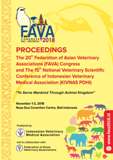JSPS-5 Activity of Medicinal Herbs Extracts Against Bovine Respiratory Syncytial Virus Infection and Co-Infection with BRSV-Pasteurella multocida adherence on MDBK Cell
Abstract
Bovine respiratory disease complex (BRDC) in calves are responsible of major economic losses in both beef and dairy production (1,2). BRDC was caused by interaction of viral and or bacterial pathogens which are mutually in major cases, this combination includes bovine respiratory syncytial virus (BRSV), bovine herpes virus, bovine viral diarrhea virus, bovine parainfluenza-3 virus, Pasteurella multocida, Mannheimia haemolytica, Mycoplasma bovis, and Histophilus somni (2). BRSV is a single negative stranded RNA virus belonging to the Paramyxoviridae family as a primary etiological agent of respiratory disease in calves of beef and dairy cattle (1,2,3). BRSV is capable of initial infection or facilitates secondary infection of the lower respiratory tract by bacteria (4,5). Recently, high density of the animals movement and extreme temperatures change causing stress and going to be respiratory problems. There is currently no specific treatment for BRDC and treatment is primarily of symptomatic. Specific treatment as an antivirals are urgently required. Herbs has known as a traditional medicinal plant used as an antiviral, anti-inflammatory and immune-stimulant (6). Given the traditional usage of herbs, this study sought to determine whether the principal bioactive ingredient of herbs possessed detectable anti-BRSV activities. However, information about antiviral treatment in Indonesia is limited. The aim of this study to determine bioactive ingredient of herbs have an anti-BRSV activities.

